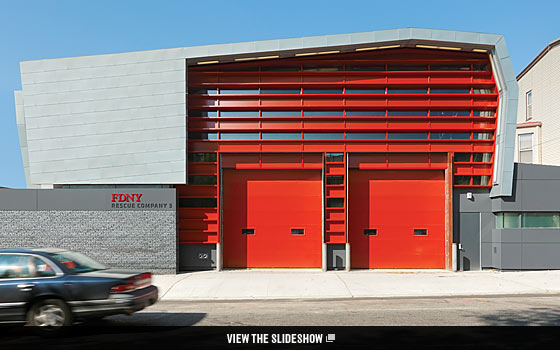
Photo: Jeff Goldberg/ESTO for Polshek Partnership
The map of Michael Bloomberg’s New York bears the scars of vast, unfinished dreams of renewal. Hudson Yards, Atlantic Yards, Coney Island, Willets Point, ground zero, Governors Island, the Gowanus Canal—all those glittering megaplans, derailed, deferred, or debased. Yet the Bloomberg administration can claim triumphs at a tiny scale: Station house by station house, library by library, the city has been doggedly smuggling high-level architecture to the neighborhoods that need it most.
In the Bronx, a shiny new firehouse stands out on its block of Washington Avenue like a bright plastic bucket on a rainy day. It’s not just the flame-colored aluminum façade, or the jaunty way the zinc cladding is slung across the roof, that makes it distinctive; it’s a combination of toughness, efficiency, and whimsy. Instead of the classic rowhouse with a big red door, the architects at Polshek Partnership have made Rescue Company 3 a showpiece of logistical economy, a tightly organized locker for equipment, vehicles, and men. The upper story looks as if it were hinged to the ground floor; you want to flip up the top and pop out the trucks.
The Fire Department has traditionally considered architecture a priority only when it’s burning down. It no longer has a choice. For decades, the trinity of quick, cheap, and ugly dominated the city’s building program. Quick was always a chimera, and cheap remains sacrosanct, but ugly won’t cut it anymore. Agencies that once indifferently crammed schoolkids, cops, low-income residents, and garbage trucks into an assortment of interchangeable brick boxes now hire brand-name architects to infuse public buildings with panache.
The change can be traced to the influence of David Burney, a British-born architect whom Bloomberg appointed commissioner of the Department of Design and Construction in 2004. Those few New Yorkers who have heard of the DDC may think of it as an invisible but omnipresent entity that keeps water mains flowing and sidewalks smooth. But with over 600 building projects in its portfolio, valued at $6 billion, the agency is also New York’s single most voracious consumer of architecture. One of Burney’s first acts as commissioner was to reject an anodyne design for a new firehouse in Bushwick that was trudging its way through the approvals process. Engine 277 and Ladder 112 deserved a home that was better than basic, he insisted, and he told the fire chiefs and the architects at STV to come up with something more distinctive. The happy result resembles a building-size fire truck with a rounded body and a windshield expanded to a curtain-wall façade.
Determined to get more for the public’s dollars, Burney put out the word that he values design and revamped the hiring process. Instead of giving jobs to the lowest bidder, he instituted a competitive process in which firms were short-listed on the basis of their achievements, then paired with a specific project later on. The latest list of preapproved firms includes Asymptote, Annabelle Selldorf, and Thomas Leeser—names whose cutting-edge luster might seem an odd fit for a senior center or police precinct. The recession has swelled the pool of available talent, DDC is energized, and officials who never expected to give much thought to architecture have become its patrons.
Burney’s record as an architects’ advocate predates his current job. A few blocks from the Bushwick firehouse, the Saratoga Avenue Community Center is the delayed result of his tenure as design director at the New York City Housing Authority. The lovingly detailed golden-brick annex, by George Ranalli, enlivens a standard-drear housing project. Inside, sunlight drops in through clerestory windows onto hardwood floors, and indestructible cement panels encircle the space like ramparts, making the room feel at once warm, safe, and grand. The building has an aura of protective dignity—nearly a year after completion, the high outside wall remains free of the graffiti that has metastasized across the street.
Even as Burney has kept prodding calcified bureaucracies, he has also had to convince architects that working for the city is not a chore of last resort. Yes, budgets are skintight, timetables flabby, and requirements inflexible. Materials must be able to endure abuse and neglect. And every design runs a gauntlet of innumerable committees, commissions, boards, and community activists. But while all these constraints can lead to unthinkingly repeated formulas, they can also create a demand for flexible thinkers, and incidentally nourish the profession’s idealistic core. “This is what you’re supposed to do if you’re an architect,” Ranalli says.
Burney has built a pipeline that, even without him, could keep dispensing good public architecture for years. Staten Island’s 121st Precinct will eventually be housed in a long, levitating slab by Rafael Viñoly. And construction should start shortly on the Glen Oaks branch of the Queens Borough Public Library, which evokes a pair of stacked grand pianos pivoting gracefully from a neighborhood of single-family houses toward a traffic artery. The architects, Scott Marble and Karen Fairbanks, have created a minor landmark and at the same time resolved the tensions of an environment where reading is a solitary act conducted in a communal space. One glass façade looks onto Union Turnpike, so that contemplative interior and cacophonous boulevard can entertain each other. Another glass wall on the side street illuminates the basement-level stacks, enriching privacy with daylight.
Burney’s wave of public buildings is striking for its motley vigor. Each design emerges from a specific constellation of site and response, not from some officially sanctioned style. Instead of imposing uniformity, the DDC is demanding imaginativeness. Rather than choosing designers that will do what they’re told, it is asking them what can be done. And so the agency quietly demonstrates that architecture is not just a tool to sell luxury condos, but a democratic art.

Saratoga Avenue Community Center, Bushwick.Photo: Paul Warchol

Rescue Company 3, the Bronx.Photo: Jeff Goldberg/ESTO for Polshek Partnership

121st Precinct, Staten Island.Rendering: Courtesy of Rafael Viñoly Architects

Glen Oaks branch of the Queens Borough Public Library.Rendering: Courtesy of Marble Fairbanks

